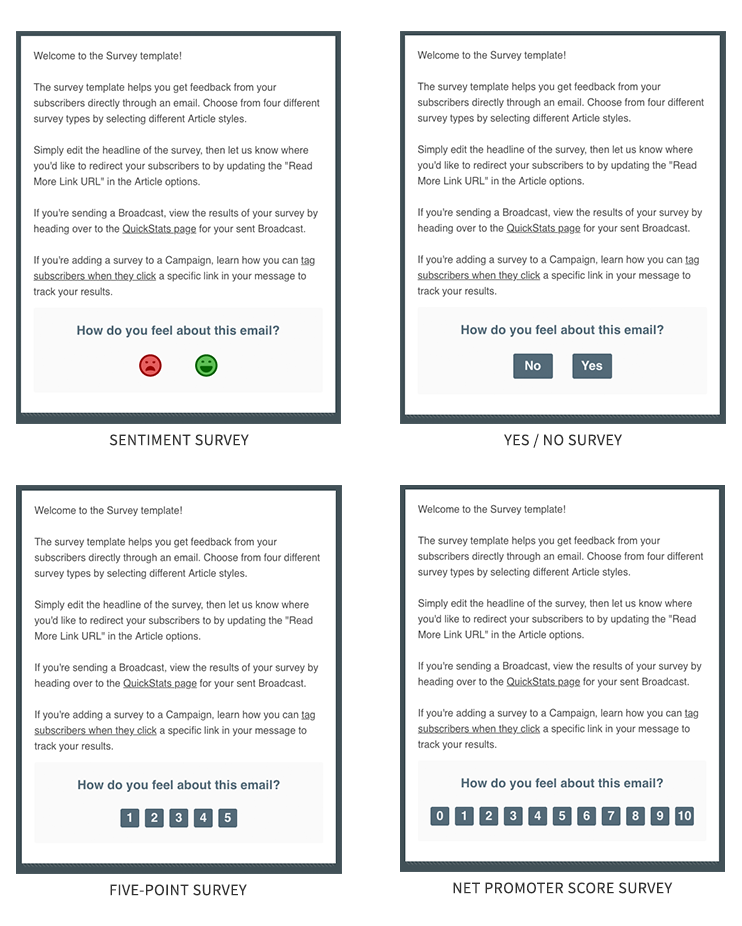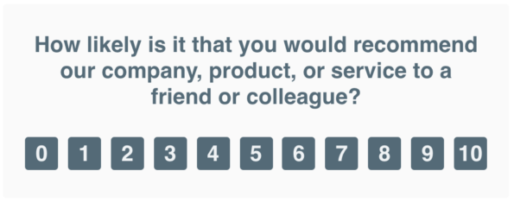4 Survey Templates You Must Send to Your Subscribers


4 Ways to Use Survey Templates to Segment Your Email Subscribers
1. Segment your audience based on how they feel
The survey template in AWeber is actually four survey options in one! Using the Drag-and-Drop Email Builder, you can toggle through the four survey types. The default option presents a simple sentiment widget, as shown below. Using a sentiment widget at the bottom of one-time broadcast emails is an effective and simple way to get a "temperature check" of how readers are responding to your emails beyond just opens and clicks. It provides you with valuable feedback so you can constantly send better, more compelling content to your readers. (Read how the sentiment widget helped us engage with more than 1,600 subscribers.) Using the template is simple and intuitive for your readers. When a subscriber clicks the happy or sad face, they are redirected by default to an image that says, “Thanks for your feedback.”
Using a sentiment widget at the bottom of one-time broadcast emails is an effective and simple way to get a "temperature check" of how readers are responding to your emails beyond just opens and clicks. It provides you with valuable feedback so you can constantly send better, more compelling content to your readers. (Read how the sentiment widget helped us engage with more than 1,600 subscribers.) Using the template is simple and intuitive for your readers. When a subscriber clicks the happy or sad face, they are redirected by default to an image that says, “Thanks for your feedback.”  But if you want further feedback, you can always redirect them to a custom destination or a quick follow-up survey using a tool like SurveyGizmo, SurveyMonkey, or Google Forms. So what happens when your subscribers clicks? That's when the real magic starts . . . Using AWeber’s click automations, you can apply the tag “happy” for subscribers that click the smiley face and an “unhappy” to those that click that frown face. Then, create a quick segment based on these tags — happy and unhappy — so you can send future broadcasts to your engaged audiences. Or, you could use those tags to trigger an automated follow up message, which is an email that AWeber can deliver using email automation. For example, if they clicked the smiley face, you could send a quick thank you and offer a bonus offer or a related piece of content. It might also be an opportune time to ask for a review or testimonial. If someone was unhappy, send an automated follow up email to invite them to provide more feedback, or offer a relevant incentive to add value for the subscriber. Here’s a quick three-minute tutorial on how to do it:
But if you want further feedback, you can always redirect them to a custom destination or a quick follow-up survey using a tool like SurveyGizmo, SurveyMonkey, or Google Forms. So what happens when your subscribers clicks? That's when the real magic starts . . . Using AWeber’s click automations, you can apply the tag “happy” for subscribers that click the smiley face and an “unhappy” to those that click that frown face. Then, create a quick segment based on these tags — happy and unhappy — so you can send future broadcasts to your engaged audiences. Or, you could use those tags to trigger an automated follow up message, which is an email that AWeber can deliver using email automation. For example, if they clicked the smiley face, you could send a quick thank you and offer a bonus offer or a related piece of content. It might also be an opportune time to ask for a review or testimonial. If someone was unhappy, send an automated follow up email to invite them to provide more feedback, or offer a relevant incentive to add value for the subscriber. Here’s a quick three-minute tutorial on how to do it:
2. Segment your audience based on an answer
Another easy way to segment your current audience is to invite them to answer one question with a single click.
- Are you just getting started with _____?
- Would you like to schedule a free consultation call?
- Interested in live webinars?
- Want to receive more information about this product?
- Did you catch the game last night?
3. Offer a range of values
Yes or no questions are great for getting explicit feedback, but sometimes the answer is not as clear cut. Using the survey template, you can present a scale: You may want to give subscribers a five-point range to answer questions like:
You may want to give subscribers a five-point range to answer questions like:
- How was the webinar?
- How interested are you in this product?
- How do you feel about _______?
- How likely are you to do ________?
4. Engage your promoters and detractors
Gauge the loyalty or advocacy of your customers with the Net Promoter Score® or NPS. It's a popular tool that many businesses use to quickly determine their customers' or subscribers' satisfaction. To determine your score, start by asking “On a scale from 1 to 10, how likely is it that you would recommend our company, product, or service to a friend or colleague?” We developed a 10-point scale variant for this specifically. NPS responses are typically grouped in the following way:
NPS responses are typically grouped in the following way:
- 9 - 10: These are your Promoters, or loyal fans and advocates. These are the customers most likely to promote your brand or product.
- 7 - 8 : These are your Passives, or satisfied customers, but not yet true advocates.
- 0 - 6 : These are your Detractors, who are currently unsatisfied, and likely candidates to leave your service.
Are you ready to survey and segment your audience?
We’ve put together a quick tutorial on how to get started with the template and read the results in AWeber’s QuickStats. Log in to your AWeber account, check out the tutorial, and get started with subscriber segmentation today. Not using AWeber? How likely are you try AWeber (free) for 30 days? 😉 If the answer is very likely, create your free trial account here.The post 4 Survey Templates You Must Send to Your Subscribers appeared first on Email Marketing Tips.
Contributer : Email Marketing Tips
4 Survey Templates You Must Send to Your Subscribers
 Reviewed by mimisabreena
on
Saturday, April 07, 2018
Rating:
Reviewed by mimisabreena
on
Saturday, April 07, 2018
Rating:
 Reviewed by mimisabreena
on
Saturday, April 07, 2018
Rating:
Reviewed by mimisabreena
on
Saturday, April 07, 2018
Rating:
















No comments:
Post a Comment